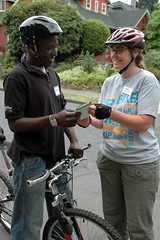Since I proposed a neighborhood meeting last week (in response to community reaction to an attack on cyclists in North Portland), I’ve been thinking about the issues, reading comments, seeking advice, and trying to determine the best way forward.
Some issues on the table — race, gentrification, youth violence — are vast and complex and I have no delusions of solving them or even tackling them directly. We can’t ignore these issues, but I think there are others in the community better suited to tackling them head-on.
So what do bikes have to do with this?
I think we can all agree that great places to ride, begin with great places to live. What if we focused the energy, idealism and dedication the bike community is known for and applied that to improving our own neighborhoods?
After all, this is not just about bikes…but maybe bikes (and the people that ride them) can be part of the solution.
Many of us care about much more than bike lanes and Bridge Pedal. But if you talk to people outside the bike scene, you realize many of them are (unfortunately) still caught up in negative images perpetuated by things like Critical Mass (someone jokingly called me “one of those bike nazis” recently).
I think we can show Portland a new side of the bike community and begin to change that perception by focusing our activism more locally; starting right outside our doorsteps.
My friend Elly Blue puts it this way:
“Bicyclists in general have a big stake in community issues because we’re more vulnerable, but the flip side of that is that we’re more invested in the landscape we’re riding through than other road users. We’ve chosen not to armor ourselves on the road so it’s up to us to reach out beyond our own immediate self-interest and make things a little safer for everyone when they get out of their cars.”
I’d like to start where Ashley Gorman and Heather Moles were attacked…which is about a mile or so from where I live and on a route I ride frequently.
And to be clear, it’s not just about this one incident. Many signs are converging around on a need for more community policing and community building. Consider these points:
- We’ve been advocating for more bike patrols even before the attacks happened.
- Many people have come forward with stories about being harassed by kids in North Portland.
- There is a major lack of involvement in many North Portland neighborhoods (eight people showed up to a recent PDOT Budget Forum).
- Mayor Potter said, “We must restore the trust between the police and the community,” in his recent State of the City address.
- North and Northeast Portland have recently seen a surge in graffiti and gang activity.
- There’s a dire lack of diversity in Portland’s cycling population.
It’s hard for me to ignore these signs. So what can we do?
I believe the first step is simply knowledge and awareness of what’s already going on. In Portland we have a well-established network of neighborhood associations. The trouble is, too many of them languish in apathy and are kept alive by a small, core group of regulars. My own neighborhood association (Piedmont), is always grumbling about a lack of attendance at meetings.
I’ve been putting off getting more involved for way too long, and I plan to start regularly attending my neighborhood meetings.
As for a general North Portland neighborhood awareness meeting, I’m still ironing out details and I’m open to your input. In addition to supplying information and advice on how to get involved, I hope to have guest speakers, representatives from surrounding neighborhoods, and an opportunity to share ideas and make connections.
One idea I’m excited about is the formation of citizen-led, volunteer bike patrols (in addition to more officers on bikes). Officer Robert Pickett from Southeast Bike Patrol has offered his time to attend the meeting and even hopes to lead a few bike patrols in North Portland to get things started.

In a few hours I’m meeting with John Canda. John is the former director of the Northeast Coalition of Neighborhoods and leader of the Mayor’s Office of Youth Violence Prevention. I look forward to hearing his input and perspectives.
Whatever happens, in the end my hope is to provide a small spark of awareness that leads to more of us getting involved, acting locally, and focusing our amazing energy and ideas to build stronger communities that aren’t just fun and safe to bike in, but are great to live in too.


